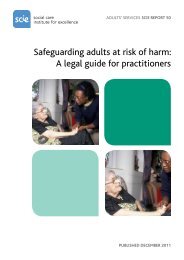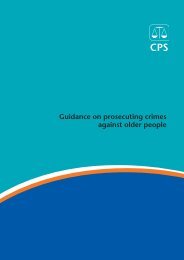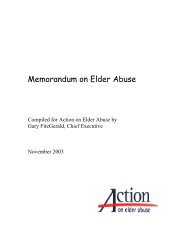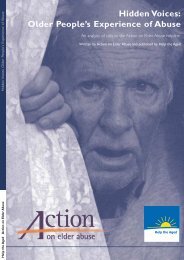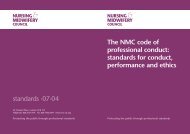NMC guidelines for records and record keeping - Action on Elder ...
NMC guidelines for records and record keeping - Action on Elder ...
NMC guidelines for records and record keeping - Action on Elder ...
Create successful ePaper yourself
Turn your PDF publications into a flip-book with our unique Google optimized e-Paper software.
&NURSINGMIDWIFERYCOUNCIL&NURSINGMIDWIFERYCOUNCILGuidelines <str<strong>on</strong>g>for</str<strong>on</strong>g><str<strong>on</strong>g><str<strong>on</strong>g>record</str<strong>on</strong>g>s</str<strong>on</strong>g> <str<strong>on</strong>g>and</str<strong>on</strong>g><str<strong>on</strong>g>record</str<strong>on</strong>g> <str<strong>on</strong>g>keeping</str<strong>on</strong>g>guidance.01.0523 Portl<str<strong>on</strong>g>and</str<strong>on</strong>g> Place, L<strong>on</strong>d<strong>on</strong> W1B 1PZTeleph<strong>on</strong>e 020 7637 7181 Fax 020 7436 2924 www.nmc-uk.orgProtecting the public through professi<strong>on</strong>al st<str<strong>on</strong>g>and</str<strong>on</strong>g>ardsProtecting the public through professi<strong>on</strong>al st<str<strong>on</strong>g>and</str<strong>on</strong>g>ards
&NURSINGMIDWIFERYCOUNCILGuidelines <str<strong>on</strong>g>for</str<strong>on</strong>g><str<strong>on</strong>g><str<strong>on</strong>g>record</str<strong>on</strong>g>s</str<strong>on</strong>g> <str<strong>on</strong>g>and</str<strong>on</strong>g><str<strong>on</strong>g>record</str<strong>on</strong>g> <str<strong>on</strong>g>keeping</str<strong>on</strong>g>Protecting the public through professi<strong>on</strong>al st<str<strong>on</strong>g>and</str<strong>on</strong>g>ards
C<strong>on</strong>tentsForeword 5Introducti<strong>on</strong> 6C<strong>on</strong>tent <str<strong>on</strong>g>and</str<strong>on</strong>g> style 7Audit 8Legal matters <str<strong>on</strong>g>and</str<strong>on</strong>g> complaints 8Access <str<strong>on</strong>g>and</str<strong>on</strong>g> ownership 10In<str<strong>on</strong>g>for</str<strong>on</strong>g>mati<strong>on</strong> technology <str<strong>on</strong>g>and</str<strong>on</strong>g> computer-held <str<strong>on</strong>g><str<strong>on</strong>g>record</str<strong>on</strong>g>s</str<strong>on</strong>g> 12Summary 14Further in<str<strong>on</strong>g>for</str<strong>on</strong>g>mati<strong>on</strong> <str<strong>on</strong>g>and</str<strong>on</strong>g> advice 1523
This versi<strong>on</strong> of Guidelines <str<strong>on</strong>g>for</str<strong>on</strong>g> <str<strong>on</strong>g><str<strong>on</strong>g>record</str<strong>on</strong>g>s</str<strong>on</strong>g> <str<strong>on</strong>g>and</str<strong>on</strong>g> <str<strong>on</strong>g>record</str<strong>on</strong>g> <str<strong>on</strong>g>keeping</str<strong>on</strong>g> was revised in August 2004to bring it into line with changes brought about by the Nursing <str<strong>on</strong>g>and</str<strong>on</strong>g> MidwiferyOrder 2001, <str<strong>on</strong>g>and</str<strong>on</strong>g> was further amended in January 2005 to clarify the in<str<strong>on</strong>g>for</str<strong>on</strong>g>mati<strong>on</strong>supplied regarding current legislati<strong>on</strong>. The original versi<strong>on</strong> was published by the<str<strong>on</strong>g>for</str<strong>on</strong>g>mer United Kingdom Central Council <str<strong>on</strong>g>for</str<strong>on</strong>g> Nursing, Midwifery <str<strong>on</strong>g>and</str<strong>on</strong>g> Health Visiting(UKCC) in October 1998. It was later revised in April 2002 following theestablishment of the Nursing <str<strong>on</strong>g>and</str<strong>on</strong>g> Midwifery Council (<str<strong>on</strong>g>NMC</str<strong>on</strong>g>). The current <str<strong>on</strong>g>guidelines</str<strong>on</strong>g>remain essentially unchanged <str<strong>on</strong>g>and</str<strong>on</strong>g> the revisi<strong>on</strong>s relate to changes in the <str<strong>on</strong>g>NMC</str<strong>on</strong>g>register <str<strong>on</strong>g>and</str<strong>on</strong>g> to historical <str<strong>on</strong>g>and</str<strong>on</strong>g> legislative updates. The <str<strong>on</strong>g>NMC</str<strong>on</strong>g> will keep these<str<strong>on</strong>g>guidelines</str<strong>on</strong>g> under review <str<strong>on</strong>g>and</str<strong>on</strong>g> will notify all registered nurses, midwives <str<strong>on</strong>g>and</str<strong>on</strong>g> specialistcommunity public health nurses whenever further amendments are made.ForewordThe Nursing <str<strong>on</strong>g>and</str<strong>on</strong>g> Midwifery Council (<str<strong>on</strong>g>NMC</str<strong>on</strong>g>) believes that <str<strong>on</strong>g>record</str<strong>on</strong>g> <str<strong>on</strong>g>keeping</str<strong>on</strong>g> isa fundamental part of nursing, midwifery <str<strong>on</strong>g>and</str<strong>on</strong>g> specialist community publichealth nursing practice. As the regulatory body <str<strong>on</strong>g>for</str<strong>on</strong>g> these professi<strong>on</strong>s, we havea legal resp<strong>on</strong>sibility to provide advice to registered nurses, midwives <str<strong>on</strong>g>and</str<strong>on</strong>g>specialist community public health nurses <strong>on</strong> st<str<strong>on</strong>g>and</str<strong>on</strong>g>ards of professi<strong>on</strong>alpractice. In 1993, the <str<strong>on</strong>g>for</str<strong>on</strong>g>mer United Kingdom Central Council <str<strong>on</strong>g>for</str<strong>on</strong>g> Nursing,Midwifery <str<strong>on</strong>g>and</str<strong>on</strong>g> Health Visiting (UKCC) published the first editi<strong>on</strong> of St<str<strong>on</strong>g>and</str<strong>on</strong>g>ards<str<strong>on</strong>g>for</str<strong>on</strong>g> <str<strong>on</strong>g><str<strong>on</strong>g>record</str<strong>on</strong>g>s</str<strong>on</strong>g> <str<strong>on</strong>g>and</str<strong>on</strong>g> <str<strong>on</strong>g>record</str<strong>on</strong>g> <str<strong>on</strong>g>keeping</str<strong>on</strong>g> to provide guidance in this area to registrants.In 1998 it published a revised sec<strong>on</strong>d editi<strong>on</strong> entitled Guidelines <str<strong>on</strong>g>for</str<strong>on</strong>g> <str<strong>on</strong>g><str<strong>on</strong>g>record</str<strong>on</strong>g>s</str<strong>on</strong>g><str<strong>on</strong>g>and</str<strong>on</strong>g> <str<strong>on</strong>g>record</str<strong>on</strong>g> <str<strong>on</strong>g>keeping</str<strong>on</strong>g>. This was reprinted in April 2002 to reflect theestablishment of the <str<strong>on</strong>g>NMC</str<strong>on</strong>g> <str<strong>on</strong>g>and</str<strong>on</strong>g> again in August 2004 to incorporatesubsequent legislative changes. Apart from these updates, the current<str<strong>on</strong>g>guidelines</str<strong>on</strong>g> remain essentially unchanged.The guidance is based up<strong>on</strong> extensive c<strong>on</strong>sultati<strong>on</strong> with organisati<strong>on</strong>s representingthe interests of patients <str<strong>on</strong>g>and</str<strong>on</strong>g> clients, registered nurses, midwives <str<strong>on</strong>g>and</str<strong>on</strong>g> specialistcommunity public health nurses, professi<strong>on</strong>al organisati<strong>on</strong>s <str<strong>on</strong>g>and</str<strong>on</strong>g> trades uni<strong>on</strong>s,employers, managers <str<strong>on</strong>g>and</str<strong>on</strong>g> legal experts in <str<strong>on</strong>g>record</str<strong>on</strong>g> <str<strong>on</strong>g>keeping</str<strong>on</strong>g>. The c<strong>on</strong>sultati<strong>on</strong> includedc<strong>on</strong>ferences, individual submissi<strong>on</strong>s <str<strong>on</strong>g>and</str<strong>on</strong>g> discussi<strong>on</strong>s, together with comments up<strong>on</strong>an earlier draft of the text.Like all <str<strong>on</strong>g>NMC</str<strong>on</strong>g> guidance, this is not a rule book that will provide the answer to everyquesti<strong>on</strong> or issue that could ever arise in the area of <str<strong>on</strong>g>record</str<strong>on</strong>g> <str<strong>on</strong>g>keeping</str<strong>on</strong>g>. Nor do webelieve that it is the role of the <str<strong>on</strong>g>NMC</str<strong>on</strong>g> in this respect to define a rigid framework <str<strong>on</strong>g>for</str<strong>on</strong>g>the c<strong>on</strong>tent <str<strong>on</strong>g>and</str<strong>on</strong>g> <str<strong>on</strong>g>for</str<strong>on</strong>g>mat of your <str<strong>on</strong>g>record</str<strong>on</strong>g> <str<strong>on</strong>g>keeping</str<strong>on</strong>g>. Instead, we seek to provide<str<strong>on</strong>g>guidelines</str<strong>on</strong>g> that we hope will help you to think through some of the issues <str<strong>on</strong>g>and</str<strong>on</strong>g> toexercise your professi<strong>on</strong>al judgement as an individual accountable registered nurse,midwife or specialist community public health nurse.We hope that you will find this booklet helpful in all aspects of your professi<strong>on</strong>alpractice.45
Introducti<strong>on</strong>Record <str<strong>on</strong>g>keeping</str<strong>on</strong>g> is an integral part of nursing, midwifery <str<strong>on</strong>g>and</str<strong>on</strong>g> specialistcommunity public health nursing practice. It is a tool of professi<strong>on</strong>al practice<str<strong>on</strong>g>and</str<strong>on</strong>g> <strong>on</strong>e that should help the care process. It is not separate from thisprocess <str<strong>on</strong>g>and</str<strong>on</strong>g> it is not an opti<strong>on</strong>al extra to be fitted in if circumstances allow.Good <str<strong>on</strong>g>record</str<strong>on</strong>g> <str<strong>on</strong>g>keeping</str<strong>on</strong>g> helps to protect the welfare of patients <str<strong>on</strong>g>and</str<strong>on</strong>g> clients bypromoting: high st<str<strong>on</strong>g>and</str<strong>on</strong>g>ards of clinical caremidwife, or specialist community public health nurse, should be aware of <str<strong>on</strong>g>and</str<strong>on</strong>g> takeinto account in your <str<strong>on</strong>g>record</str<strong>on</strong>g> <str<strong>on</strong>g>keeping</str<strong>on</strong>g> practice. The following secti<strong>on</strong>s set out theseprinciples <str<strong>on</strong>g>and</str<strong>on</strong>g> legal aspects. They are designed to help you to reflect up<strong>on</strong> yourcurrent <str<strong>on</strong>g>record</str<strong>on</strong>g> <str<strong>on</strong>g>keeping</str<strong>on</strong>g> practice <str<strong>on</strong>g>and</str<strong>on</strong>g> how you can develop it in order to benefityour patients <str<strong>on</strong>g>and</str<strong>on</strong>g> clients.The principles set out in this document apply across all care settings <str<strong>on</strong>g>and</str<strong>on</strong>g> to bothmanual <str<strong>on</strong>g>and</str<strong>on</strong>g> computer-held <str<strong>on</strong>g><str<strong>on</strong>g>record</str<strong>on</strong>g>s</str<strong>on</strong>g>. The <str<strong>on</strong>g>NMC</str<strong>on</strong>g> accepts that, until there is nati<strong>on</strong>alagreement between all health care professi<strong>on</strong>s <strong>on</strong> st<str<strong>on</strong>g>and</str<strong>on</strong>g>ards <str<strong>on</strong>g>and</str<strong>on</strong>g> <str<strong>on</strong>g>for</str<strong>on</strong>g>mat, <str<strong>on</strong>g><str<strong>on</strong>g>record</str<strong>on</strong>g>s</str<strong>on</strong>g>may differ depending <strong>on</strong> the needs of the patient or client. The <str<strong>on</strong>g>record</str<strong>on</strong>g> must,however, follow a logical <str<strong>on</strong>g>and</str<strong>on</strong>g> methodical sequence with clear milest<strong>on</strong>es <str<strong>on</strong>g>and</str<strong>on</strong>g> goals<str<strong>on</strong>g>for</str<strong>on</strong>g> the <str<strong>on</strong>g>record</str<strong>on</strong>g> <str<strong>on</strong>g>keeping</str<strong>on</strong>g> process. c<strong>on</strong>tinuity of care better communicati<strong>on</strong> <str<strong>on</strong>g>and</str<strong>on</strong>g> disseminati<strong>on</strong> of in<str<strong>on</strong>g>for</str<strong>on</strong>g>mati<strong>on</strong> between members ofthe inter-professi<strong>on</strong>al health care teamThe <str<strong>on</strong>g>NMC</str<strong>on</strong>g> also advises that it is good practice to retain <str<strong>on</strong>g><str<strong>on</strong>g>record</str<strong>on</strong>g>s</str<strong>on</strong>g> with reference tothe Human Rights Act 2000 <str<strong>on</strong>g>and</str<strong>on</strong>g> the Caldicott Report 1997. an accurate account of treatment <str<strong>on</strong>g>and</str<strong>on</strong>g> care planning <str<strong>on</strong>g>and</str<strong>on</strong>g> deliveryC<strong>on</strong>tent <str<strong>on</strong>g>and</str<strong>on</strong>g> style the ability to detect problems, such as changes in the patient’s or client’sc<strong>on</strong>diti<strong>on</strong>, at an early stage.The quality of your <str<strong>on</strong>g>record</str<strong>on</strong>g> <str<strong>on</strong>g>keeping</str<strong>on</strong>g> is also a reflecti<strong>on</strong> of the st<str<strong>on</strong>g>and</str<strong>on</strong>g>ard of yourprofessi<strong>on</strong>al practice. Good <str<strong>on</strong>g>record</str<strong>on</strong>g> <str<strong>on</strong>g>keeping</str<strong>on</strong>g> is a mark of the skilled <str<strong>on</strong>g>and</str<strong>on</strong>g> safepractiti<strong>on</strong>er, whilst careless or incomplete <str<strong>on</strong>g>record</str<strong>on</strong>g> <str<strong>on</strong>g>keeping</str<strong>on</strong>g> often highlights widerproblems with the individual’s practice.There are a number of factors that c<strong>on</strong>tribute to effective <str<strong>on</strong>g>record</str<strong>on</strong>g> <str<strong>on</strong>g>keeping</str<strong>on</strong>g>. Patient<str<strong>on</strong>g>and</str<strong>on</strong>g> client <str<strong>on</strong>g><str<strong>on</strong>g>record</str<strong>on</strong>g>s</str<strong>on</strong>g> should: be factual, c<strong>on</strong>sistent <str<strong>on</strong>g>and</str<strong>on</strong>g> accurate be written as so<strong>on</strong> as possible after an event has occurred, providing currentin<str<strong>on</strong>g>for</str<strong>on</strong>g>mati<strong>on</strong> <strong>on</strong> the care <str<strong>on</strong>g>and</str<strong>on</strong>g> c<strong>on</strong>diti<strong>on</strong> of the patient or client be written clearly <str<strong>on</strong>g>and</str<strong>on</strong>g> in such a manner that the text cannot be erased6There is no single model or template <str<strong>on</strong>g>for</str<strong>on</strong>g> a <str<strong>on</strong>g>record</str<strong>on</strong>g>. The best <str<strong>on</strong>g>record</str<strong>on</strong>g> is <strong>on</strong>e that is theproduct of the c<strong>on</strong>sultati<strong>on</strong> <str<strong>on</strong>g>and</str<strong>on</strong>g> discussi<strong>on</strong> which has taken place at a local levelbetween all members of the inter-professi<strong>on</strong>al health care team <str<strong>on</strong>g>and</str<strong>on</strong>g> the patient orclient. It is <strong>on</strong>e that is evaluated <str<strong>on</strong>g>and</str<strong>on</strong>g> adapted in resp<strong>on</strong>se to the needs of patients<str<strong>on</strong>g>and</str<strong>on</strong>g> clients. It is <strong>on</strong>e that enables any registrant to care <str<strong>on</strong>g>for</str<strong>on</strong>g> the patient or client,regardless of where they are within the care process or care envir<strong>on</strong>ment. It is aninvaluable way of promoting communicati<strong>on</strong> within the health care team <str<strong>on</strong>g>and</str<strong>on</strong>g>between practiti<strong>on</strong>ers <str<strong>on</strong>g>and</str<strong>on</strong>g> their patients or clients. Good <str<strong>on</strong>g>record</str<strong>on</strong>g> <str<strong>on</strong>g>keeping</str<strong>on</strong>g> is,there<str<strong>on</strong>g>for</str<strong>on</strong>g>e, both the product of good team work <str<strong>on</strong>g>and</str<strong>on</strong>g> an important tool inpromoting high quality health care.The <str<strong>on</strong>g>NMC</str<strong>on</strong>g> believes that there are a number of key principles that underpin good<str<strong>on</strong>g><str<strong>on</strong>g>record</str<strong>on</strong>g>s</str<strong>on</strong>g> <str<strong>on</strong>g>and</str<strong>on</strong>g> <str<strong>on</strong>g>record</str<strong>on</strong>g> <str<strong>on</strong>g>keeping</str<strong>on</strong>g>. Some of these relate to the c<strong>on</strong>tent <str<strong>on</strong>g>and</str<strong>on</strong>g> style of the<str<strong>on</strong>g>record</str<strong>on</strong>g>. In additi<strong>on</strong>, there are some legal issues that you, as a registered nurse, be written in such a manner that any alterati<strong>on</strong>s or additi<strong>on</strong>s are dated, timed<str<strong>on</strong>g>and</str<strong>on</strong>g> signed in such a way that the original entry can still be read clearly be accurately dated, timed <str<strong>on</strong>g>and</str<strong>on</strong>g> signed, with the signature printed al<strong>on</strong>gside thefirst entry not include abbreviati<strong>on</strong>s, jarg<strong>on</strong>, meaningless phrases, irrelevant speculati<strong>on</strong><str<strong>on</strong>g>and</str<strong>on</strong>g> offensive subjective statements be readable <strong>on</strong> any photocopies.In additi<strong>on</strong>, <str<strong>on</strong>g><str<strong>on</strong>g>record</str<strong>on</strong>g>s</str<strong>on</strong>g> should: be written, wherever possible, with the involvement of the patient, client ortheir carer be written in terms that the patient or client can underst<str<strong>on</strong>g>and</str<strong>on</strong>g>7
e c<strong>on</strong>secutive identify problems that have arisen <str<strong>on</strong>g>and</str<strong>on</strong>g> the acti<strong>on</strong> taken to rectify them provide clear evidence of the care planned, the decisi<strong>on</strong>s made, the caredelivered <str<strong>on</strong>g>and</str<strong>on</strong>g> the in<str<strong>on</strong>g>for</str<strong>on</strong>g>mati<strong>on</strong> shared.AuditAudit is <strong>on</strong>e comp<strong>on</strong>ent of the risk management process, the aim of which isthe promoti<strong>on</strong> of quality. If improvements are identified <str<strong>on</strong>g>and</str<strong>on</strong>g> made in theprocesses <str<strong>on</strong>g>and</str<strong>on</strong>g> outcomes of health care, risks to the patient or client areminimised <str<strong>on</strong>g>and</str<strong>on</strong>g> costs to the employer are reduced.Audit can play a vital part in ensuring the quality of care that is delivered <str<strong>on</strong>g>and</str<strong>on</strong>g> thisapplies equally to the process of <str<strong>on</strong>g>record</str<strong>on</strong>g> <str<strong>on</strong>g>keeping</str<strong>on</strong>g>. By auditing your <str<strong>on</strong>g><str<strong>on</strong>g>record</str<strong>on</strong>g>s</str<strong>on</strong>g>, you canassess the st<str<strong>on</strong>g>and</str<strong>on</strong>g>ard of the <str<strong>on</strong>g><str<strong>on</strong>g>record</str<strong>on</strong>g>s</str<strong>on</strong>g> <str<strong>on</strong>g>and</str<strong>on</strong>g> identify areas <str<strong>on</strong>g>for</str<strong>on</strong>g> improvement <str<strong>on</strong>g>and</str<strong>on</strong>g> staffdevelopment. Audit tools should there<str<strong>on</strong>g>for</str<strong>on</strong>g>e be devised at a local level to m<strong>on</strong>itorthe st<str<strong>on</strong>g>and</str<strong>on</strong>g>ard of the <str<strong>on</strong>g><str<strong>on</strong>g>record</str<strong>on</strong>g>s</str<strong>on</strong>g> produced <str<strong>on</strong>g>and</str<strong>on</strong>g> to <str<strong>on</strong>g>for</str<strong>on</strong>g>m a basis both <str<strong>on</strong>g>for</str<strong>on</strong>g> discussi<strong>on</strong> <str<strong>on</strong>g>and</str<strong>on</strong>g>measurement. Whatever audit tool or system is used, it should primarily bedirected towards serving the interests of your patients <str<strong>on</strong>g>and</str<strong>on</strong>g> clients, rather thanorganisati<strong>on</strong>al c<strong>on</strong>venience. You may also wish to c<strong>on</strong>sider including a system ofpeer review in the process. The need to maintain c<strong>on</strong>fidentiality of patient <str<strong>on</strong>g>and</str<strong>on</strong>g>client in<str<strong>on</strong>g>for</str<strong>on</strong>g>mati<strong>on</strong> applies to audit just as to the <str<strong>on</strong>g>record</str<strong>on</strong>g> <str<strong>on</strong>g>keeping</str<strong>on</strong>g> process itself.Legal matters <str<strong>on</strong>g>and</str<strong>on</strong>g> complaintsPatient <str<strong>on</strong>g>and</str<strong>on</strong>g> client <str<strong>on</strong>g><str<strong>on</strong>g>record</str<strong>on</strong>g>s</str<strong>on</strong>g> are sometimes called in evidence in order toinvestigate a complaint at a local level or <str<strong>on</strong>g>for</str<strong>on</strong>g> criminal proceedings. They mayalso be used in evidence by the <str<strong>on</strong>g>NMC</str<strong>on</strong>g>’s Fitness to Practise committees, whichc<strong>on</strong>sider complaints about registered nurses, midwives <str<strong>on</strong>g>and</str<strong>on</strong>g> specialistcommunity public health nurses. Care plans, diaries, birth plans <str<strong>on</strong>g>and</str<strong>on</strong>g>anything that makes reference to the care of the patient or client may berequired as evidence.As a registered nurse, midwife or specialist community public health nurse, youhave both a professi<strong>on</strong>al <str<strong>on</strong>g>and</str<strong>on</strong>g> a legal duty of care. Your <str<strong>on</strong>g>record</str<strong>on</strong>g> <str<strong>on</strong>g>keeping</str<strong>on</strong>g> shouldthere<str<strong>on</strong>g>for</str<strong>on</strong>g>e be able to dem<strong>on</strong>strate: a full account of your assessment <str<strong>on</strong>g>and</str<strong>on</strong>g> the care you have planned <str<strong>on</strong>g>and</str<strong>on</strong>g> provided relevant in<str<strong>on</strong>g>for</str<strong>on</strong>g>mati<strong>on</strong> about the c<strong>on</strong>diti<strong>on</strong> of the patient or client at any giventime <str<strong>on</strong>g>and</str<strong>on</strong>g> the measures you have taken to resp<strong>on</strong>d to their needs evidence that you have understood <str<strong>on</strong>g>and</str<strong>on</strong>g> h<strong>on</strong>oured your duty of care, that you havetaken all reas<strong>on</strong>able steps to care <str<strong>on</strong>g>for</str<strong>on</strong>g> the patient or client <str<strong>on</strong>g>and</str<strong>on</strong>g> that any acti<strong>on</strong>s oromissi<strong>on</strong>s <strong>on</strong> your part have not compromised their safety in any way a <str<strong>on</strong>g>record</str<strong>on</strong>g> of any arrangements you have made <str<strong>on</strong>g>for</str<strong>on</strong>g> the c<strong>on</strong>tinuing care of apatient or client.The frequency of entries will be determined both by your professi<strong>on</strong>al judgement<str<strong>on</strong>g>and</str<strong>on</strong>g> local st<str<strong>on</strong>g>and</str<strong>on</strong>g>ards <str<strong>on</strong>g>and</str<strong>on</strong>g> agreements. You will need to exercise particular care <str<strong>on</strong>g>and</str<strong>on</strong>g>make more frequent entries when patients or clients present complex problems,show deviati<strong>on</strong> from the norm, require more intensive care than normal, arec<strong>on</strong>fused <str<strong>on</strong>g>and</str<strong>on</strong>g> disoriented or generally give cause <str<strong>on</strong>g>for</str<strong>on</strong>g> c<strong>on</strong>cern. You must use yourprofessi<strong>on</strong>al judgement (if necessary in discussi<strong>on</strong> with other members of thehealth care team) to determine when these circumstances exist.The approach to <str<strong>on</strong>g>record</str<strong>on</strong>g> <str<strong>on</strong>g>keeping</str<strong>on</strong>g> that courts of law adopt tends to be that ‘if it is not<str<strong>on</strong>g>record</str<strong>on</strong>g>ed, it has not been d<strong>on</strong>e’. You must use your professi<strong>on</strong>al judgement todecide what is relevant <str<strong>on</strong>g>and</str<strong>on</strong>g> what should be <str<strong>on</strong>g>record</str<strong>on</strong>g>ed. This applies particularly tosituati<strong>on</strong>s where the c<strong>on</strong>diti<strong>on</strong> of the patient or client is apparently unchanging <str<strong>on</strong>g>and</str<strong>on</strong>g>no <str<strong>on</strong>g>record</str<strong>on</strong>g> has been made of the care delivered. Local st<str<strong>on</strong>g>and</str<strong>on</strong>g>ards should be set todefine what is a reas<strong>on</strong>able time lapse if this is the case. Midwives must ensure thatthey are aware of <str<strong>on</strong>g>and</str<strong>on</strong>g> comply with the requirements set out in the <str<strong>on</strong>g>NMC</str<strong>on</strong>g>’s Midwivesrules <str<strong>on</strong>g>and</str<strong>on</strong>g> st<str<strong>on</strong>g>and</str<strong>on</strong>g>ards that relate to the maintenance <str<strong>on</strong>g>and</str<strong>on</strong>g> retenti<strong>on</strong> of <str<strong>on</strong>g><str<strong>on</strong>g>record</str<strong>on</strong>g>s</str<strong>on</strong>g>.If you are working with clients who are subject to mental health legislati<strong>on</strong>, youmust ensure that you have a thorough working knowledge of these statutorypowers as they apply to your particular area of practice. When making entries in<str<strong>on</strong>g><str<strong>on</strong>g>record</str<strong>on</strong>g>s</str<strong>on</strong>g> <str<strong>on</strong>g>for</str<strong>on</strong>g> these clients, you must comply as appropriate with the guidance givenby the Mental Health Act Commissi<strong>on</strong> <str<strong>on</strong>g>for</str<strong>on</strong>g> Engl<str<strong>on</strong>g>and</str<strong>on</strong>g> <str<strong>on</strong>g>and</str<strong>on</strong>g> Wales, the Mental WelfareCommissi<strong>on</strong> <str<strong>on</strong>g>for</str<strong>on</strong>g> Scotl<str<strong>on</strong>g>and</str<strong>on</strong>g> or the Mental Health Commissi<strong>on</strong> <str<strong>on</strong>g>for</str<strong>on</strong>g> Northern Irel<str<strong>on</strong>g>and</str<strong>on</strong>g>.8In making a <str<strong>on</strong>g>record</str<strong>on</strong>g>, you should also be aware of the reliance which yourprofessi<strong>on</strong>al colleagues will have up<strong>on</strong> it. Good communicati<strong>on</strong> is there<str<strong>on</strong>g>for</str<strong>on</strong>g>e9
essential. Furthermore, you are professi<strong>on</strong>ally accountable <str<strong>on</strong>g>for</str<strong>on</strong>g> ensuring that anyduties that you delegate to those members of the inter-professi<strong>on</strong>al health careteam who are not registered practiti<strong>on</strong>ers are undertaken to a reas<strong>on</strong>able st<str<strong>on</strong>g>and</str<strong>on</strong>g>ard.For instance, if you delegate <str<strong>on</strong>g>record</str<strong>on</strong>g> <str<strong>on</strong>g>keeping</str<strong>on</strong>g> to pre-registrati<strong>on</strong> students of nursingor midwifery or to health care assistants, you must ensure that they are adequatelysupervised <str<strong>on</strong>g>and</str<strong>on</strong>g> that they are competent to per<str<strong>on</strong>g>for</str<strong>on</strong>g>m the task. You must clearlycountersign any such entry <str<strong>on</strong>g>and</str<strong>on</strong>g> remember that you are professi<strong>on</strong>ally accountable<str<strong>on</strong>g>for</str<strong>on</strong>g> the c<strong>on</strong>sequences of such an entry. You must ensure that any entry you make ina <str<strong>on</strong>g>record</str<strong>on</strong>g> can easily be identified. If your signature is unclear, you should print yourname al<strong>on</strong>gside it. You are str<strong>on</strong>gly advised not to use your initials <strong>on</strong>ly as asignature.The most up to date in<str<strong>on</strong>g>for</str<strong>on</strong>g>mati<strong>on</strong> <str<strong>on</strong>g>for</str<strong>on</strong>g> dealing with applicati<strong>on</strong>s <str<strong>on</strong>g>for</str<strong>on</strong>g> access isexplained in detail <strong>on</strong> the Department of Health webpage at www.dh.gov.uk underPolicy <str<strong>on</strong>g>and</str<strong>on</strong>g> Guidance, In<str<strong>on</strong>g>for</str<strong>on</strong>g>mati<strong>on</strong> Policy, Patient C<strong>on</strong>fidentiality <str<strong>on</strong>g>and</str<strong>on</strong>g> Access toHealth Records.You should also be aware of the Freedom of In<str<strong>on</strong>g>for</str<strong>on</strong>g>mati<strong>on</strong> Act 2000, which introducednew legislati<strong>on</strong> with effect from 2005. However, NHS bodies were expected to becompliant by October 2003. This legislati<strong>on</strong> grants rights of access to any<strong>on</strong>e, to allin<str<strong>on</strong>g>for</str<strong>on</strong>g>mati<strong>on</strong> that is not covered by the Data Protecti<strong>on</strong> Act 1998,ie. in<str<strong>on</strong>g>for</str<strong>on</strong>g>mati<strong>on</strong> which does not c<strong>on</strong>tain patient identifiable details.Inter-professi<strong>on</strong>al access to <str<strong>on</strong>g><str<strong>on</strong>g>record</str<strong>on</strong>g>s</str<strong>on</strong>g>The <str<strong>on</strong>g>NMC</str<strong>on</strong>g> supports the principle of shared <str<strong>on</strong>g><str<strong>on</strong>g>record</str<strong>on</strong>g>s</str<strong>on</strong>g> in which all members of thehealth care team involved in the care <str<strong>on</strong>g>and</str<strong>on</strong>g> treatment of an individual make entriesin a single <str<strong>on</strong>g>record</str<strong>on</strong>g> <str<strong>on</strong>g>and</str<strong>on</strong>g> in accordance with an agreed local protocol. The ability toobtain in<str<strong>on</strong>g>for</str<strong>on</strong>g>mati<strong>on</strong> whilst respecting patient <str<strong>on</strong>g>and</str<strong>on</strong>g> client c<strong>on</strong>fidentiality is essential.Each practiti<strong>on</strong>er’s c<strong>on</strong>tributi<strong>on</strong> to such <str<strong>on</strong>g><str<strong>on</strong>g>record</str<strong>on</strong>g>s</str<strong>on</strong>g> should be seen as of equalimportance. This reflects the wider value of collaborative working within the interprofessi<strong>on</strong>alhealth care team.The same right of access to <str<strong>on</strong>g><str<strong>on</strong>g>record</str<strong>on</strong>g>s</str<strong>on</strong>g> by the patient or client exists where a system ofshared <str<strong>on</strong>g><str<strong>on</strong>g>record</str<strong>on</strong>g>s</str<strong>on</strong>g> is in use. It is essential, there<str<strong>on</strong>g>for</str<strong>on</strong>g>e, that local agreement is reached toidentify <str<strong>on</strong>g>and</str<strong>on</strong>g> publicise who is resp<strong>on</strong>sible <str<strong>on</strong>g>for</str<strong>on</strong>g> c<strong>on</strong>sidering requests from patients <str<strong>on</strong>g>and</str<strong>on</strong>g>clients <str<strong>on</strong>g>for</str<strong>on</strong>g> access in particular circumstances.10Access <str<strong>on</strong>g>and</str<strong>on</strong>g> ownershipYou need to assume that any entries you make in a patient or client <str<strong>on</strong>g>record</str<strong>on</strong>g>will be scrutinised at some point. Patients <str<strong>on</strong>g>and</str<strong>on</strong>g> clients not <strong>on</strong>ly have a legalright to see their <str<strong>on</strong>g><str<strong>on</strong>g>record</str<strong>on</strong>g>s</str<strong>on</strong>g> but they are increasingly participating in writing<str<strong>on</strong>g>and</str<strong>on</strong>g> holding them.Access to <str<strong>on</strong>g><str<strong>on</strong>g>record</str<strong>on</strong>g>s</str<strong>on</strong>g> – legal aspectsA patient's right of access to health <str<strong>on</strong>g><str<strong>on</strong>g>record</str<strong>on</strong>g>s</str<strong>on</strong>g> is now governed by the provisi<strong>on</strong>s ofthe Data Protecti<strong>on</strong> Act 1998. The Access to Health Records Act 1990 has mostlybeen superseded by the Data Protecti<strong>on</strong> Act 1998, <str<strong>on</strong>g>and</str<strong>on</strong>g> now <strong>on</strong>ly governs access tothe health <str<strong>on</strong>g><str<strong>on</strong>g>record</str<strong>on</strong>g>s</str<strong>on</strong>g> of deceased people.The Data Protecti<strong>on</strong> Act 1998 replaces the Data Protecti<strong>on</strong> Act 1984 <str<strong>on</strong>g>and</str<strong>on</strong>g> givespatients <str<strong>on</strong>g>and</str<strong>on</strong>g> clients access to their paper-based <str<strong>on</strong>g>and</str<strong>on</strong>g> computer-held <str<strong>on</strong>g><str<strong>on</strong>g>record</str<strong>on</strong>g>s</str<strong>on</strong>g>. Itregulates the storage <str<strong>on</strong>g>and</str<strong>on</strong>g> protecti<strong>on</strong> of patient <str<strong>on</strong>g>and</str<strong>on</strong>g> client in<str<strong>on</strong>g>for</str<strong>on</strong>g>mati<strong>on</strong> held <strong>on</strong>computer. Its remit also includes access to the health <str<strong>on</strong>g><str<strong>on</strong>g>record</str<strong>on</strong>g>s</str<strong>on</strong>g> of living people, <str<strong>on</strong>g>and</str<strong>on</strong>g>patients’ rights to have inaccurate in<str<strong>on</strong>g>for</str<strong>on</strong>g>mati<strong>on</strong> corrected.In some cases, registered nurses, midwives <str<strong>on</strong>g>and</str<strong>on</strong>g> specialist community public healthnurses can withhold in<str<strong>on</strong>g>for</str<strong>on</strong>g>mati<strong>on</strong> from a patient or client that they believe couldcause serious harm to the physical or mental health of the patient or client, orwhich would breach the c<strong>on</strong>fidentiality of another patient or client. If you make thedecisi<strong>on</strong> to withhold in<str<strong>on</strong>g>for</str<strong>on</strong>g>mati<strong>on</strong> in this way, you must be able to justify it <str<strong>on</strong>g>and</str<strong>on</strong>g> youmust <str<strong>on</strong>g>record</str<strong>on</strong>g> it.Retenti<strong>on</strong>The period <str<strong>on</strong>g>for</str<strong>on</strong>g> which patient or client <str<strong>on</strong>g><str<strong>on</strong>g>record</str<strong>on</strong>g>s</str<strong>on</strong>g> may be required to be kept c<str<strong>on</strong>g>and</str<strong>on</strong>g>epend up<strong>on</strong> a number of pieces of legislati<strong>on</strong> or health services policy statementsissued by government health departments. Your employer should have protocolsthat you should follow <str<strong>on</strong>g>and</str<strong>on</strong>g> which will probably require you to keep any <str<strong>on</strong>g>record</str<strong>on</strong>g> youhave made <str<strong>on</strong>g>for</str<strong>on</strong>g> at least eight years <str<strong>on</strong>g>and</str<strong>on</strong>g>, in the case of a child, at least to the date ofthe child’s 21st birthday. If you are self-employed, you should also ensure that no<str<strong>on</strong>g>record</str<strong>on</strong>g> you have made relating to the care of a patient or client is destroyed withina period of eight, or 21, years respectively as above.Ownership of <str<strong>on</strong>g><str<strong>on</strong>g>record</str<strong>on</strong>g>s</str<strong>on</strong>g>Organisati<strong>on</strong>s that employ professi<strong>on</strong>al staff who make <str<strong>on</strong>g><str<strong>on</strong>g>record</str<strong>on</strong>g>s</str<strong>on</strong>g> are the legal ownersof those <str<strong>on</strong>g><str<strong>on</strong>g>record</str<strong>on</strong>g>s</str<strong>on</strong>g>. This does not mean, however, that any<strong>on</strong>e in the organisati<strong>on</strong> hasan automatic right of access to the <str<strong>on</strong>g><str<strong>on</strong>g>record</str<strong>on</strong>g>s</str<strong>on</strong>g> or the in<str<strong>on</strong>g>for</str<strong>on</strong>g>mati<strong>on</strong> c<strong>on</strong>tained within11
them. You have a duty to protect the c<strong>on</strong>fidentiality of the patient or client <str<strong>on</strong>g>record</str<strong>on</strong>g>.This is particularly important when there are potential areas of c<strong>on</strong>flict, such asoccupati<strong>on</strong>al health <str<strong>on</strong>g><str<strong>on</strong>g>record</str<strong>on</strong>g>s</str<strong>on</strong>g>, where the <str<strong>on</strong>g>record</str<strong>on</strong>g> itself bel<strong>on</strong>g to the organisati<strong>on</strong> butthe in<str<strong>on</strong>g>for</str<strong>on</strong>g>mati<strong>on</strong> c<strong>on</strong>tained in the <str<strong>on</strong>g>record</str<strong>on</strong>g> is c<strong>on</strong>fidential <str<strong>on</strong>g>and</str<strong>on</strong>g> should <strong>on</strong>ly be released,even to some<strong>on</strong>e within the organisati<strong>on</strong>, with the c<strong>on</strong>sent of the patient or client.Patient-held <str<strong>on</strong>g><str<strong>on</strong>g>record</str<strong>on</strong>g>s</str<strong>on</strong>g>Patients <str<strong>on</strong>g>and</str<strong>on</strong>g> clients increasingly own their health care <str<strong>on</strong>g><str<strong>on</strong>g>record</str<strong>on</strong>g>s</str<strong>on</strong>g> <str<strong>on</strong>g>and</str<strong>on</strong>g> this should beencouraged as far as it is appropriate <str<strong>on</strong>g>and</str<strong>on</strong>g> as l<strong>on</strong>g as they are happy to do so. Itenables them to be more closely involved in their own care <str<strong>on</strong>g>and</str<strong>on</strong>g> enables you toshare with them the in<str<strong>on</strong>g>for</str<strong>on</strong>g>mati<strong>on</strong> that you c<strong>on</strong>sider relevant to your assessment <str<strong>on</strong>g>and</str<strong>on</strong>g>care of them. Patients <str<strong>on</strong>g>and</str<strong>on</strong>g> clients should be in<str<strong>on</strong>g>for</str<strong>on</strong>g>med of the purpose <str<strong>on</strong>g>and</str<strong>on</strong>g>importance of the <str<strong>on</strong>g>record</str<strong>on</strong>g> <str<strong>on</strong>g>and</str<strong>on</strong>g> their resp<strong>on</strong>sibility <str<strong>on</strong>g>for</str<strong>on</strong>g> <str<strong>on</strong>g>keeping</str<strong>on</strong>g> it safe. These sameprinciples apply equally to parent-held <str<strong>on</strong>g><str<strong>on</strong>g>record</str<strong>on</strong>g>s</str<strong>on</strong>g>.Sometimes, you may feel that your particular c<strong>on</strong>cerns or anxieties require you tokeep a supplementary <str<strong>on</strong>g>record</str<strong>on</strong>g> to which access by the patient, client or familymembers is limited or withheld. Keeping a supplementary <str<strong>on</strong>g>record</str<strong>on</strong>g> should be theexcepti<strong>on</strong> rather than the norm, however, <str<strong>on</strong>g>and</str<strong>on</strong>g> should not extend to <str<strong>on</strong>g>keeping</str<strong>on</strong>g> fullduplicate <str<strong>on</strong>g><str<strong>on</strong>g>record</str<strong>on</strong>g>s</str<strong>on</strong>g>. Wherever possible, c<strong>on</strong>cerns should be shared with the patientor client <str<strong>on</strong>g>and</str<strong>on</strong>g> the relevant entry should be jointly compiled. You must be able tojustify <str<strong>on</strong>g>keeping</str<strong>on</strong>g> such a supplementary <str<strong>on</strong>g>record</str<strong>on</strong>g> <str<strong>on</strong>g>and</str<strong>on</strong>g> its existence needs to be madeclear to other members of the health care team, who must be able to access thein<str<strong>on</strong>g>for</str<strong>on</strong>g>mati<strong>on</strong> readily but without compromising patient <str<strong>on</strong>g>and</str<strong>on</strong>g> client c<strong>on</strong>fidentiality.Research, teaching <str<strong>on</strong>g>and</str<strong>on</strong>g> accessPatient <str<strong>on</strong>g>and</str<strong>on</strong>g> client <str<strong>on</strong>g><str<strong>on</strong>g>record</str<strong>on</strong>g>s</str<strong>on</strong>g> may be used <str<strong>on</strong>g>for</str<strong>on</strong>g> research, teaching purposes <str<strong>on</strong>g>and</str<strong>on</strong>g> clinicalsupervisi<strong>on</strong>. The principles of access <str<strong>on</strong>g>and</str<strong>on</strong>g> c<strong>on</strong>fidentiality remain the same <str<strong>on</strong>g>and</str<strong>on</strong>g> theright of the patient or client to refuse access to their <str<strong>on</strong>g><str<strong>on</strong>g>record</str<strong>on</strong>g>s</str<strong>on</strong>g> should be respected.The use of patient or client <str<strong>on</strong>g><str<strong>on</strong>g>record</str<strong>on</strong>g>s</str<strong>on</strong>g> in research should be approved by your localresearch ethics committee.In<str<strong>on</strong>g>for</str<strong>on</strong>g>mati<strong>on</strong> technology <str<strong>on</strong>g>and</str<strong>on</strong>g>computer-held <str<strong>on</strong>g><str<strong>on</strong>g>record</str<strong>on</strong>g>s</str<strong>on</strong>g>Many registered nurses, midwives <str<strong>on</strong>g>and</str<strong>on</strong>g> specialist community public healthnurses regularly use in<str<strong>on</strong>g>for</str<strong>on</strong>g>mati<strong>on</strong> technology to <str<strong>on</strong>g>record</str<strong>on</strong>g> the planning,assessment <str<strong>on</strong>g>and</str<strong>on</strong>g> delivery of care. There are obvious advantages to this.Computer-held <str<strong>on</strong>g><str<strong>on</strong>g>record</str<strong>on</strong>g>s</str<strong>on</strong>g> tend to be easier to read, less bulky, reduce the need<str<strong>on</strong>g>for</str<strong>on</strong>g> duplicati<strong>on</strong> <str<strong>on</strong>g>and</str<strong>on</strong>g> can increase communicati<strong>on</strong> across the inter-professi<strong>on</strong>alhealth care team. However, the same basic principles that apply to manual<str<strong>on</strong>g><str<strong>on</strong>g>record</str<strong>on</strong>g>s</str<strong>on</strong>g> must be applied to computer-held <str<strong>on</strong>g><str<strong>on</strong>g>record</str<strong>on</strong>g>s</str<strong>on</strong>g>. You do not need to keepmanual duplicates of computer-held <str<strong>on</strong>g><str<strong>on</strong>g>record</str<strong>on</strong>g>s</str<strong>on</strong>g> <str<strong>on</strong>g>and</str<strong>on</strong>g> they do not replace theneed to maintain dialogue throughout the inter-professi<strong>on</strong>al health careteam. Safeguards <str<strong>on</strong>g>for</str<strong>on</strong>g> computer-held <str<strong>on</strong>g><str<strong>on</strong>g>record</str<strong>on</strong>g>s</str<strong>on</strong>g> must be in compliance with theComputer Misuse Act 1990.Security, access <str<strong>on</strong>g>and</str<strong>on</strong>g> c<strong>on</strong>fidentialityThe principle of the c<strong>on</strong>fidentiality of in<str<strong>on</strong>g>for</str<strong>on</strong>g>mati<strong>on</strong> held about your patients <str<strong>on</strong>g>and</str<strong>on</strong>g>clients is just as important in computer-held <str<strong>on</strong>g><str<strong>on</strong>g>record</str<strong>on</strong>g>s</str<strong>on</strong>g> as in all other <str<strong>on</strong>g><str<strong>on</strong>g>record</str<strong>on</strong>g>s</str<strong>on</strong>g>,including those sent by fax. You are professi<strong>on</strong>ally accountable <str<strong>on</strong>g>for</str<strong>on</strong>g> making sure thatwhatever system is used is fully secure. Clear local protocols should be drawn up tospecify which staff have access to computer-held <str<strong>on</strong>g><str<strong>on</strong>g>record</str<strong>on</strong>g>s</str<strong>on</strong>g>. Although patients <str<strong>on</strong>g>and</str<strong>on</strong>g>clients can expect their health <str<strong>on</strong>g><str<strong>on</strong>g>record</str<strong>on</strong>g>s</str<strong>on</strong>g> to be accessed by different members of theinter-professi<strong>on</strong>al health care team, this should <strong>on</strong>ly be d<strong>on</strong>e where necessary.Patients <str<strong>on</strong>g>and</str<strong>on</strong>g> clients do not have the right to limit the amount of in<str<strong>on</strong>g>for</str<strong>on</strong>g>mati<strong>on</strong>relevant to their care or c<strong>on</strong>diti<strong>on</strong> that is incorporated in their <str<strong>on</strong>g><str<strong>on</strong>g>record</str<strong>on</strong>g>s</str<strong>on</strong>g>. However,they can limit access to certain in<str<strong>on</strong>g>for</str<strong>on</strong>g>mati<strong>on</strong> about themselves <str<strong>on</strong>g>and</str<strong>on</strong>g> you must respecttheir right to do so. Local <str<strong>on</strong>g>guidelines</str<strong>on</strong>g> <str<strong>on</strong>g>and</str<strong>on</strong>g> protocols should address this right <str<strong>on</strong>g>and</str<strong>on</strong>g>these procedures should also include ways of establishing the date <str<strong>on</strong>g>and</str<strong>on</strong>g> time of anyentry, the pers<strong>on</strong> who made the entry, <str<strong>on</strong>g>and</str<strong>on</strong>g> should ensure that any changes oradditi<strong>on</strong>s to entries are made in such a way that the original in<str<strong>on</strong>g>for</str<strong>on</strong>g>mati<strong>on</strong> is stillvisible <str<strong>on</strong>g>and</str<strong>on</strong>g> accessible.12Patient <str<strong>on</strong>g>and</str<strong>on</strong>g> client involvementAs with manual <str<strong>on</strong>g><str<strong>on</strong>g>record</str<strong>on</strong>g>s</str<strong>on</strong>g>, patients <str<strong>on</strong>g>and</str<strong>on</strong>g> clients should be equal partners, wheneverpossible, in the compilati<strong>on</strong> of their own <str<strong>on</strong>g><str<strong>on</strong>g>record</str<strong>on</strong>g>s</str<strong>on</strong>g>. The Data Protecti<strong>on</strong> Act 1998,13
the Access Modificati<strong>on</strong> (Health) Order 1987, the Access to Health Records Act1990 <str<strong>on</strong>g>and</str<strong>on</strong>g> the Access to Health Records (Northern Irel<str<strong>on</strong>g>and</str<strong>on</strong>g>) Order 1993 define theirrights of access. Procedures must be in accordance with the Freedom ofIn<str<strong>on</strong>g>for</str<strong>on</strong>g>mati<strong>on</strong> Act 2000.Accountability <str<strong>on</strong>g>and</str<strong>on</strong>g> computer-held <str<strong>on</strong>g><str<strong>on</strong>g>record</str<strong>on</strong>g>s</str<strong>on</strong>g>You are accountable <str<strong>on</strong>g>for</str<strong>on</strong>g> any entry you make to a computer-held <str<strong>on</strong>g>record</str<strong>on</strong>g> <str<strong>on</strong>g>and</str<strong>on</strong>g> youmust ensure that any entry you make is clearly identifiable.Summary Record <str<strong>on</strong>g>keeping</str<strong>on</strong>g> is an integral part of nursing, midwifery <str<strong>on</strong>g>and</str<strong>on</strong>g> specialistcommunity public health nursing practice Good <str<strong>on</strong>g>record</str<strong>on</strong>g> <str<strong>on</strong>g>keeping</str<strong>on</strong>g> is a mark of the skilled <str<strong>on</strong>g>and</str<strong>on</strong>g> safe practiti<strong>on</strong>er Records should not include abbreviati<strong>on</strong>s, jarg<strong>on</strong>, meaningless phrases, irrelevantspeculati<strong>on</strong> <str<strong>on</strong>g>and</str<strong>on</strong>g> offensive subjective statements Records should be written in terms that the patient or client can easilyunderst<str<strong>on</strong>g>and</str<strong>on</strong>g> By auditing your <str<strong>on</strong>g><str<strong>on</strong>g>record</str<strong>on</strong>g>s</str<strong>on</strong>g>, you can assess the st<str<strong>on</strong>g>and</str<strong>on</strong>g>ard of the <str<strong>on</strong>g>record</str<strong>on</strong>g> <str<strong>on</strong>g>and</str<strong>on</strong>g> identifyareas <str<strong>on</strong>g>for</str<strong>on</strong>g> improvement <str<strong>on</strong>g>and</str<strong>on</strong>g> staff development You must ensure that any entry you make in a <str<strong>on</strong>g>record</str<strong>on</strong>g> can easily be identified Patients <str<strong>on</strong>g>and</str<strong>on</strong>g> clients have the right of access to <str<strong>on</strong>g><str<strong>on</strong>g>record</str<strong>on</strong>g>s</str<strong>on</strong>g> held about them Each practiti<strong>on</strong>er’s c<strong>on</strong>tributi<strong>on</strong> to <str<strong>on</strong>g><str<strong>on</strong>g>record</str<strong>on</strong>g>s</str<strong>on</strong>g> should be seen as of equal importance You have a duty to protect the c<strong>on</strong>fidentiality of the patient <str<strong>on</strong>g>and</str<strong>on</strong>g> client <str<strong>on</strong>g>record</str<strong>on</strong>g> Patients <str<strong>on</strong>g>and</str<strong>on</strong>g> clients should own their health care <str<strong>on</strong>g><str<strong>on</strong>g>record</str<strong>on</strong>g>s</str<strong>on</strong>g> as far as it is appropriate<str<strong>on</strong>g>and</str<strong>on</strong>g> as l<strong>on</strong>g as they are happy to do so The principle of the c<strong>on</strong>fidentiality of in<str<strong>on</strong>g>for</str<strong>on</strong>g>mati<strong>on</strong> held about your patients <str<strong>on</strong>g>and</str<strong>on</strong>g>clients is just as important in computer-held <str<strong>on</strong>g><str<strong>on</strong>g>record</str<strong>on</strong>g>s</str<strong>on</strong>g> as in all other <str<strong>on</strong>g><str<strong>on</strong>g>record</str<strong>on</strong>g>s</str<strong>on</strong>g> The use of <str<strong>on</strong>g><str<strong>on</strong>g>record</str<strong>on</strong>g>s</str<strong>on</strong>g> in research should be approved by your local research ethicscommittee You must use your professi<strong>on</strong>al judgement to decide what is relevant <str<strong>on</strong>g>and</str<strong>on</strong>g> whatshould be <str<strong>on</strong>g>record</str<strong>on</strong>g>ed Records should be written clearly <str<strong>on</strong>g>and</str<strong>on</strong>g> in such a manner that the text can not beerased Records should be factual, c<strong>on</strong>sistent <str<strong>on</strong>g>and</str<strong>on</strong>g> accurate You need to assume that any entries you make in a patient or client <str<strong>on</strong>g>record</str<strong>on</strong>g> willbe scrutinised at some point Good <str<strong>on</strong>g>record</str<strong>on</strong>g> <str<strong>on</strong>g>keeping</str<strong>on</strong>g> helps to protect the welfare of patients <str<strong>on</strong>g>and</str<strong>on</strong>g> clients.1415
ReferencesAccess to Health Records Act 1990 – Department of Health. The Stati<strong>on</strong>ery Office,Norwich, www.hmso.gov.ukCaldicott Report 1997 – Department of Health. The Stati<strong>on</strong>ery Office, Norwich,www.hmso.gov.ukComputer Misuse Act 1990 – The Home Office. The Stati<strong>on</strong>ery Office, Norwich,www.hmso.gov.ukData Protecti<strong>on</strong> Act 1998 – The Home Office. The Stati<strong>on</strong>ery Office, Norwich,www.hmso.gov.ukFreedom of In<str<strong>on</strong>g>for</str<strong>on</strong>g>mati<strong>on</strong> Act 2000 – The Home Office. The Stati<strong>on</strong>ery Office,Norwich, www.hmso.gov.ukHuman Rights Act 2000 – The Home Office. The Stati<strong>on</strong>ery Office, Norwich,www.hmso.gov.ukFurther in<str<strong>on</strong>g>for</str<strong>on</strong>g>mati<strong>on</strong> <str<strong>on</strong>g>and</str<strong>on</strong>g> adviceWe hope that you have found this booklet helpful. Further in<str<strong>on</strong>g>for</str<strong>on</strong>g>mati<strong>on</strong> <str<strong>on</strong>g>and</str<strong>on</strong>g> adviceare available by c<strong>on</strong>tacting the <str<strong>on</strong>g>NMC</str<strong>on</strong>g>’s professi<strong>on</strong>al advice service by teleph<strong>on</strong>e <strong>on</strong>020 7333 6541/6550/6553, by e-mail at advice@nmc-uk.org, by fax <strong>on</strong>020 7333 6538 or via the <str<strong>on</strong>g>NMC</str<strong>on</strong>g>’s web site at www.nmc-uk.org. For a list of current<str<strong>on</strong>g>NMC</str<strong>on</strong>g> publicati<strong>on</strong>s, please refer to our web site at www.nmc-uk.org or write to thePublicati<strong>on</strong>s Department at the <str<strong>on</strong>g>NMC</str<strong>on</strong>g>’s address or e-mail publicati<strong>on</strong>s@nmc-uk.org.Please note that copies of the government legislati<strong>on</strong> cited in these<str<strong>on</strong>g>guidelines</str<strong>on</strong>g> are available from your local branch of The Stati<strong>on</strong>ery Office <str<strong>on</strong>g>and</str<strong>on</strong>g>not from the <str<strong>on</strong>g>NMC</str<strong>on</strong>g>.16Published by the Nursing <str<strong>on</strong>g>and</str<strong>on</strong>g> Midwifery Council in January 2005.



